Report on Resourcing and Talent Planning: Labour Market Trends
VerifiedAdded on 2023/02/01
|19
|5171
|43
Report
AI Summary
This report analyzes resourcing and talent planning, focusing on labour market trends in the UK and France. It examines unemployment and employment rates, labour demand, and the roles of government, trade unions, and employers. The report explores strategic positioning by organizations to attract and retain talent, including discussions on employee benefits, working conditions, and wage structures. It also delves into the principles of effective workforce planning, differentiating between strategic and operational approaches. The analysis covers key aspects such as skill gaps, recruitment challenges, and the impact of government policies on the labour market. The report provides insights into the challenges faced by employers in both countries and offers recommendations for improving workforce planning and talent acquisition strategies. The document also includes figures and tables to represent the data for better understanding.
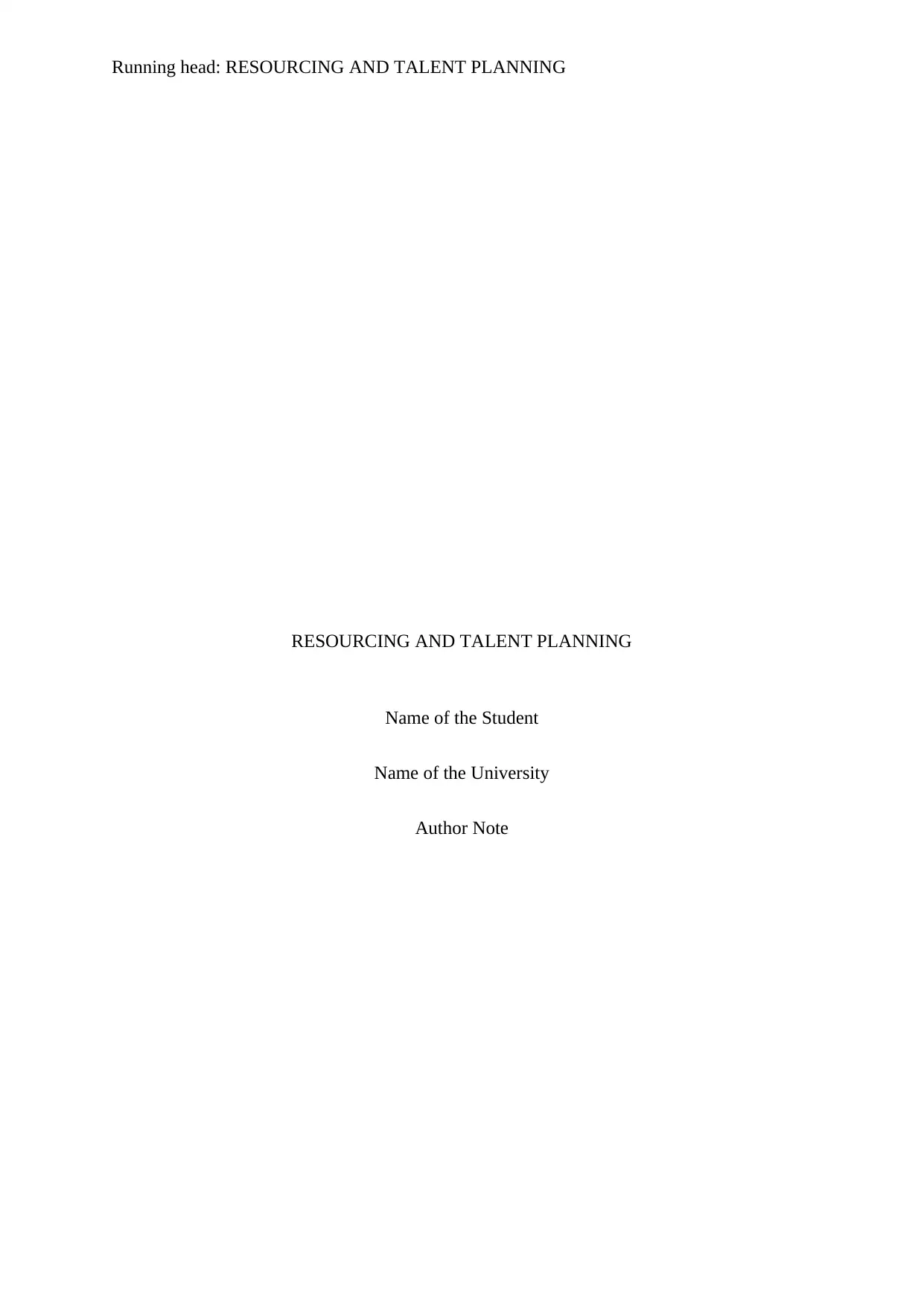
Running head: RESOURCING AND TALENT PLANNING
RESOURCING AND TALENT PLANNING
Name of the Student
Name of the University
Author Note
RESOURCING AND TALENT PLANNING
Name of the Student
Name of the University
Author Note
Paraphrase This Document
Need a fresh take? Get an instant paraphrase of this document with our AI Paraphraser
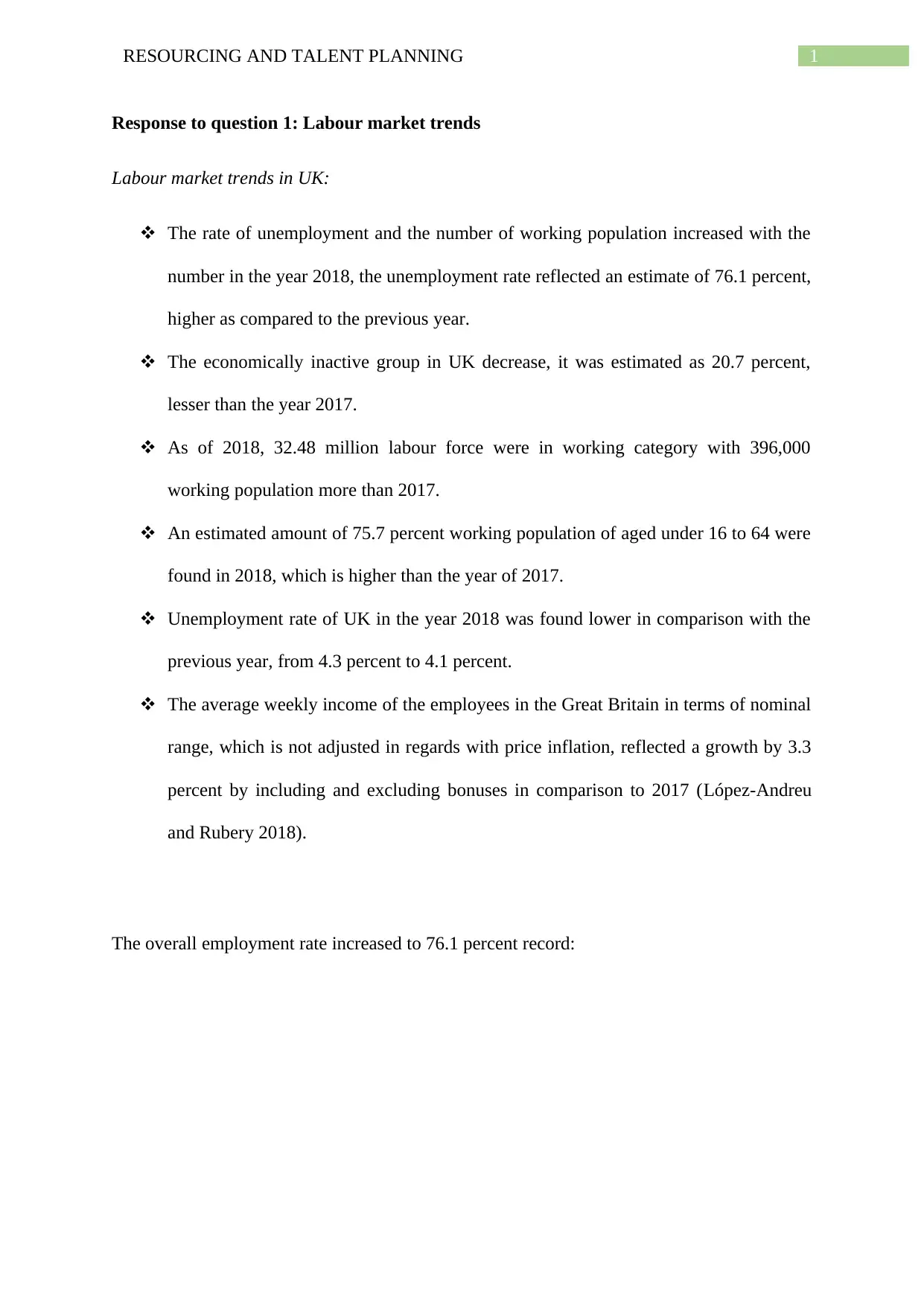
1RESOURCING AND TALENT PLANNING
Response to question 1: Labour market trends
Labour market trends in UK:
The rate of unemployment and the number of working population increased with the
number in the year 2018, the unemployment rate reflected an estimate of 76.1 percent,
higher as compared to the previous year.
The economically inactive group in UK decrease, it was estimated as 20.7 percent,
lesser than the year 2017.
As of 2018, 32.48 million labour force were in working category with 396,000
working population more than 2017.
An estimated amount of 75.7 percent working population of aged under 16 to 64 were
found in 2018, which is higher than the year of 2017.
Unemployment rate of UK in the year 2018 was found lower in comparison with the
previous year, from 4.3 percent to 4.1 percent.
The average weekly income of the employees in the Great Britain in terms of nominal
range, which is not adjusted in regards with price inflation, reflected a growth by 3.3
percent by including and excluding bonuses in comparison to 2017 (López-Andreu
and Rubery 2018).
The overall employment rate increased to 76.1 percent record:
Response to question 1: Labour market trends
Labour market trends in UK:
The rate of unemployment and the number of working population increased with the
number in the year 2018, the unemployment rate reflected an estimate of 76.1 percent,
higher as compared to the previous year.
The economically inactive group in UK decrease, it was estimated as 20.7 percent,
lesser than the year 2017.
As of 2018, 32.48 million labour force were in working category with 396,000
working population more than 2017.
An estimated amount of 75.7 percent working population of aged under 16 to 64 were
found in 2018, which is higher than the year of 2017.
Unemployment rate of UK in the year 2018 was found lower in comparison with the
previous year, from 4.3 percent to 4.1 percent.
The average weekly income of the employees in the Great Britain in terms of nominal
range, which is not adjusted in regards with price inflation, reflected a growth by 3.3
percent by including and excluding bonuses in comparison to 2017 (López-Andreu
and Rubery 2018).
The overall employment rate increased to 76.1 percent record:
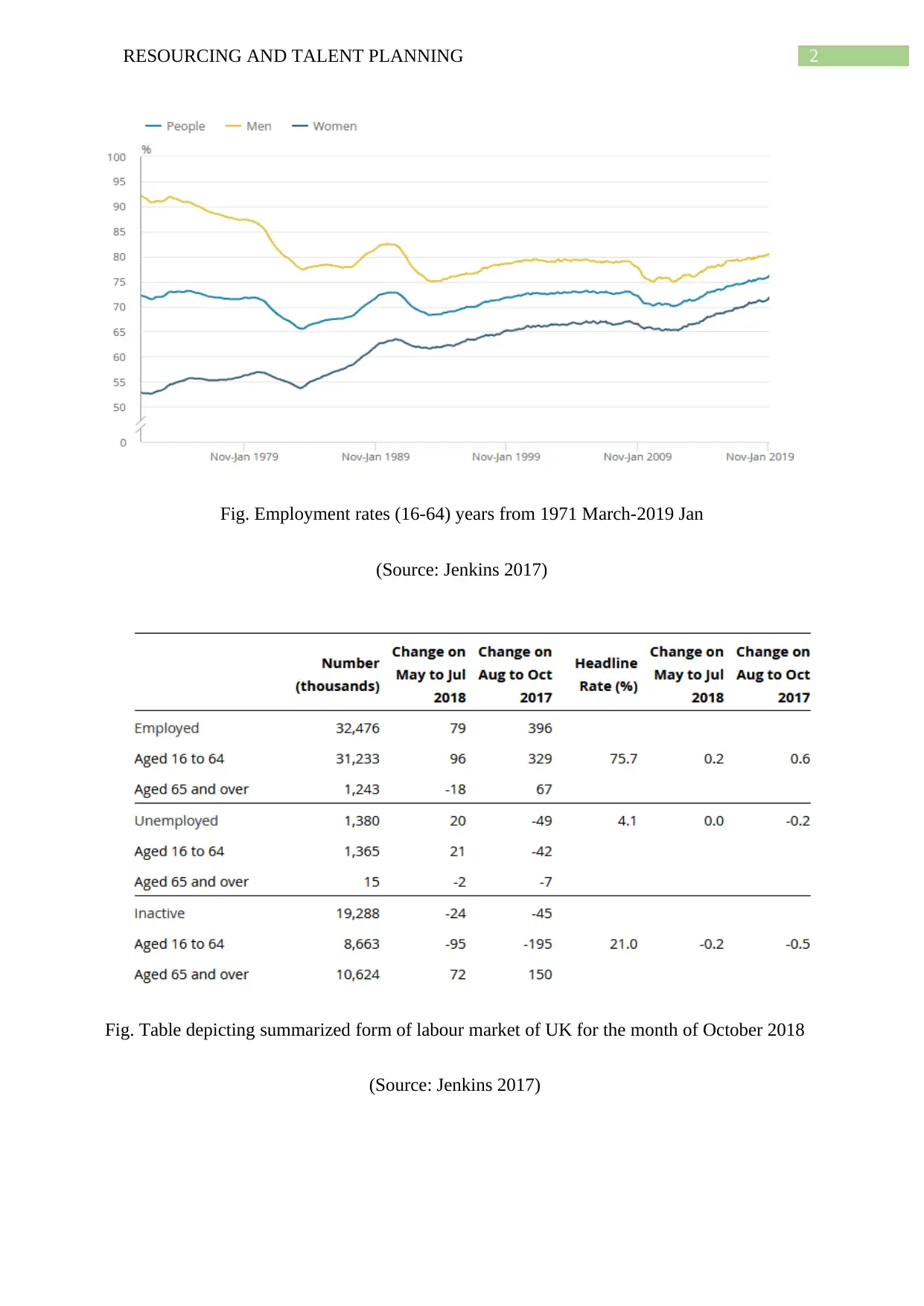
2RESOURCING AND TALENT PLANNING
Fig. Employment rates (16-64) years from 1971 March-2019 Jan
(Source: Jenkins 2017)
Fig. Table depicting summarized form of labour market of UK for the month of October 2018
(Source: Jenkins 2017)
Fig. Employment rates (16-64) years from 1971 March-2019 Jan
(Source: Jenkins 2017)
Fig. Table depicting summarized form of labour market of UK for the month of October 2018
(Source: Jenkins 2017)
⊘ This is a preview!⊘
Do you want full access?
Subscribe today to unlock all pages.

Trusted by 1+ million students worldwide

3RESOURCING AND TALENT PLANNING
Labour demand-
The net employment rate in the quarter’s record and/or the gap between the
proportions of the employers has reflected a rise by 22 points as compared to the last quarter
of 2018. The data reflects higher unit of employment confidence. The lack of skilled labours
were identified with the difficulty in filling existent vacancies by the employees, 61 percent
of the organizations framed the value of complexities. The activities of retention and
recruitment demonstrated challenges for the employers. Around 33 percent of the employers
of UK depicted the challenge of retaining existent staff members. 41 percent of the employers
were found experiencing challenges in recruiting skilled labour force. The trend increasing
the skills of existent employees. These trends were observed in the 43 percent of the
employers. Around 29 percent of the employers adopted the strategy of increasing wages in
United Kingdom. Another strategy of recruiting trainees for increasing the labour force was
observed, a total of 23 percent of the employers were observed adopting this strategy
(Khoudja and Platt 2018).
The basic pay rate in the 12 months of 2018 and the expectation up to the year of
2020 (March) is projected to be 2 percent, reflects a consistent report as compared to the
previous trends of the employers. In United Kingdom, the expected increase in the basic pay
for private sector organizations reflected a fall from 2.5 percent to 2 percent. In the public
sector organization, the expectations for the basic pay reflected a rise up to 1.5 percent from 1
percent. However, the statistics figure from ONS report reflected a different scenario, the
country have experienced an increase in the earnings of the workforce (excluding the bonus)
by around 3.4 percent. The trend of increasing the initial salary in the process of recruitment
for addressing the challenge of retention and recruitment in United Kingdom. The consumer
price in relation to the inflation decreased by 2 percent of the target rate of the year 2019.
Due to the ‘increasing wage rate’ strategy, the consumer spending rate increase in the year
2018. However, the increasing rate of wages doesn’t reflected in the rate of production or
Labour demand-
The net employment rate in the quarter’s record and/or the gap between the
proportions of the employers has reflected a rise by 22 points as compared to the last quarter
of 2018. The data reflects higher unit of employment confidence. The lack of skilled labours
were identified with the difficulty in filling existent vacancies by the employees, 61 percent
of the organizations framed the value of complexities. The activities of retention and
recruitment demonstrated challenges for the employers. Around 33 percent of the employers
of UK depicted the challenge of retaining existent staff members. 41 percent of the employers
were found experiencing challenges in recruiting skilled labour force. The trend increasing
the skills of existent employees. These trends were observed in the 43 percent of the
employers. Around 29 percent of the employers adopted the strategy of increasing wages in
United Kingdom. Another strategy of recruiting trainees for increasing the labour force was
observed, a total of 23 percent of the employers were observed adopting this strategy
(Khoudja and Platt 2018).
The basic pay rate in the 12 months of 2018 and the expectation up to the year of
2020 (March) is projected to be 2 percent, reflects a consistent report as compared to the
previous trends of the employers. In United Kingdom, the expected increase in the basic pay
for private sector organizations reflected a fall from 2.5 percent to 2 percent. In the public
sector organization, the expectations for the basic pay reflected a rise up to 1.5 percent from 1
percent. However, the statistics figure from ONS report reflected a different scenario, the
country have experienced an increase in the earnings of the workforce (excluding the bonus)
by around 3.4 percent. The trend of increasing the initial salary in the process of recruitment
for addressing the challenge of retention and recruitment in United Kingdom. The consumer
price in relation to the inflation decreased by 2 percent of the target rate of the year 2019.
Due to the ‘increasing wage rate’ strategy, the consumer spending rate increase in the year
2018. However, the increasing rate of wages doesn’t reflected in the rate of production or
Paraphrase This Document
Need a fresh take? Get an instant paraphrase of this document with our AI Paraphraser
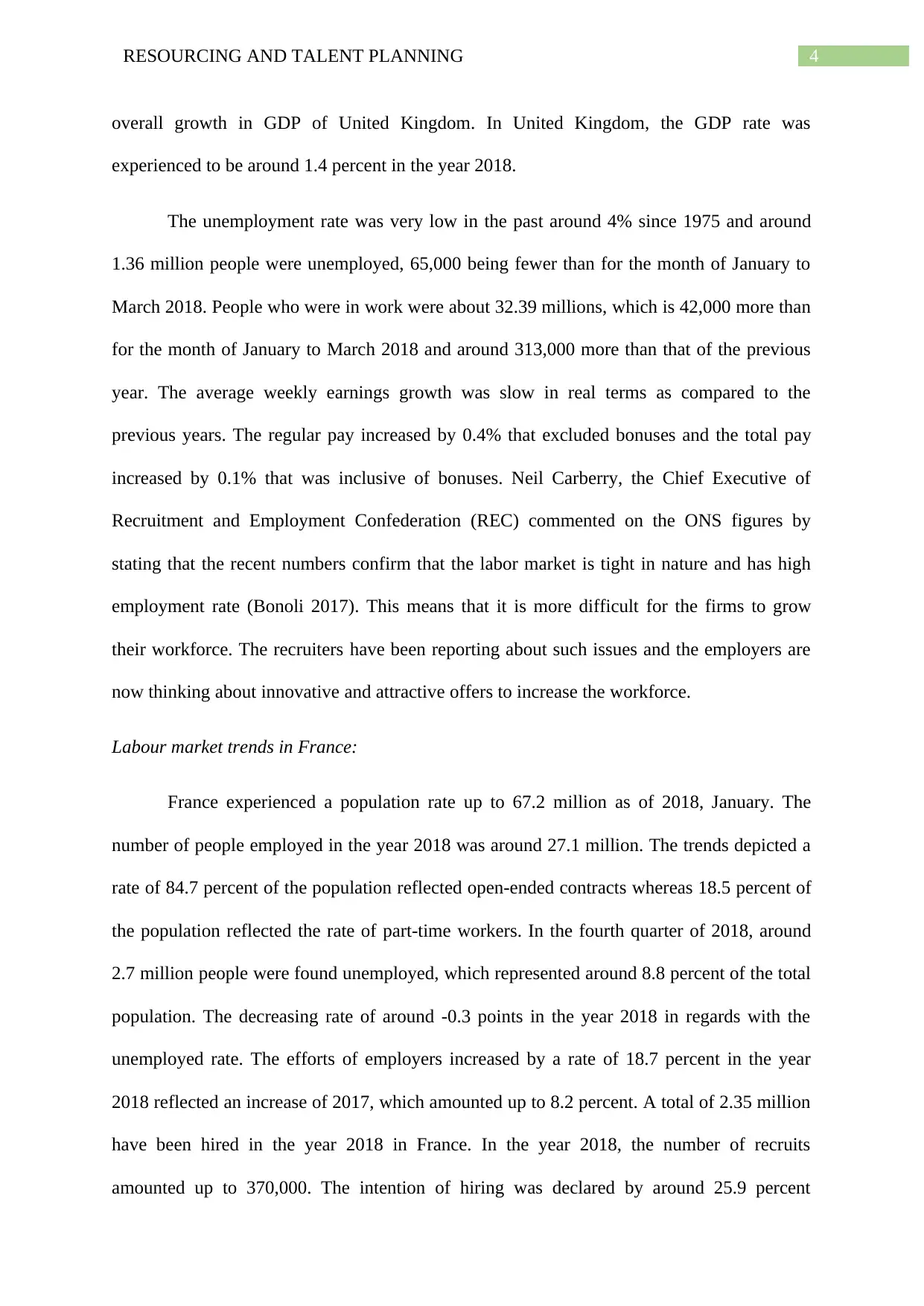
4RESOURCING AND TALENT PLANNING
overall growth in GDP of United Kingdom. In United Kingdom, the GDP rate was
experienced to be around 1.4 percent in the year 2018.
The unemployment rate was very low in the past around 4% since 1975 and around
1.36 million people were unemployed, 65,000 being fewer than for the month of January to
March 2018. People who were in work were about 32.39 millions, which is 42,000 more than
for the month of January to March 2018 and around 313,000 more than that of the previous
year. The average weekly earnings growth was slow in real terms as compared to the
previous years. The regular pay increased by 0.4% that excluded bonuses and the total pay
increased by 0.1% that was inclusive of bonuses. Neil Carberry, the Chief Executive of
Recruitment and Employment Confederation (REC) commented on the ONS figures by
stating that the recent numbers confirm that the labor market is tight in nature and has high
employment rate (Bonoli 2017). This means that it is more difficult for the firms to grow
their workforce. The recruiters have been reporting about such issues and the employers are
now thinking about innovative and attractive offers to increase the workforce.
Labour market trends in France:
France experienced a population rate up to 67.2 million as of 2018, January. The
number of people employed in the year 2018 was around 27.1 million. The trends depicted a
rate of 84.7 percent of the population reflected open-ended contracts whereas 18.5 percent of
the population reflected the rate of part-time workers. In the fourth quarter of 2018, around
2.7 million people were found unemployed, which represented around 8.8 percent of the total
population. The decreasing rate of around -0.3 points in the year 2018 in regards with the
unemployed rate. The efforts of employers increased by a rate of 18.7 percent in the year
2018 reflected an increase of 2017, which amounted up to 8.2 percent. A total of 2.35 million
have been hired in the year 2018 in France. In the year 2018, the number of recruits
amounted up to 370,000. The intention of hiring was declared by around 25.9 percent
overall growth in GDP of United Kingdom. In United Kingdom, the GDP rate was
experienced to be around 1.4 percent in the year 2018.
The unemployment rate was very low in the past around 4% since 1975 and around
1.36 million people were unemployed, 65,000 being fewer than for the month of January to
March 2018. People who were in work were about 32.39 millions, which is 42,000 more than
for the month of January to March 2018 and around 313,000 more than that of the previous
year. The average weekly earnings growth was slow in real terms as compared to the
previous years. The regular pay increased by 0.4% that excluded bonuses and the total pay
increased by 0.1% that was inclusive of bonuses. Neil Carberry, the Chief Executive of
Recruitment and Employment Confederation (REC) commented on the ONS figures by
stating that the recent numbers confirm that the labor market is tight in nature and has high
employment rate (Bonoli 2017). This means that it is more difficult for the firms to grow
their workforce. The recruiters have been reporting about such issues and the employers are
now thinking about innovative and attractive offers to increase the workforce.
Labour market trends in France:
France experienced a population rate up to 67.2 million as of 2018, January. The
number of people employed in the year 2018 was around 27.1 million. The trends depicted a
rate of 84.7 percent of the population reflected open-ended contracts whereas 18.5 percent of
the population reflected the rate of part-time workers. In the fourth quarter of 2018, around
2.7 million people were found unemployed, which represented around 8.8 percent of the total
population. The decreasing rate of around -0.3 points in the year 2018 in regards with the
unemployed rate. The efforts of employers increased by a rate of 18.7 percent in the year
2018 reflected an increase of 2017, which amounted up to 8.2 percent. A total of 2.35 million
have been hired in the year 2018 in France. In the year 2018, the number of recruits
amounted up to 370,000. The intention of hiring was declared by around 25.9 percent
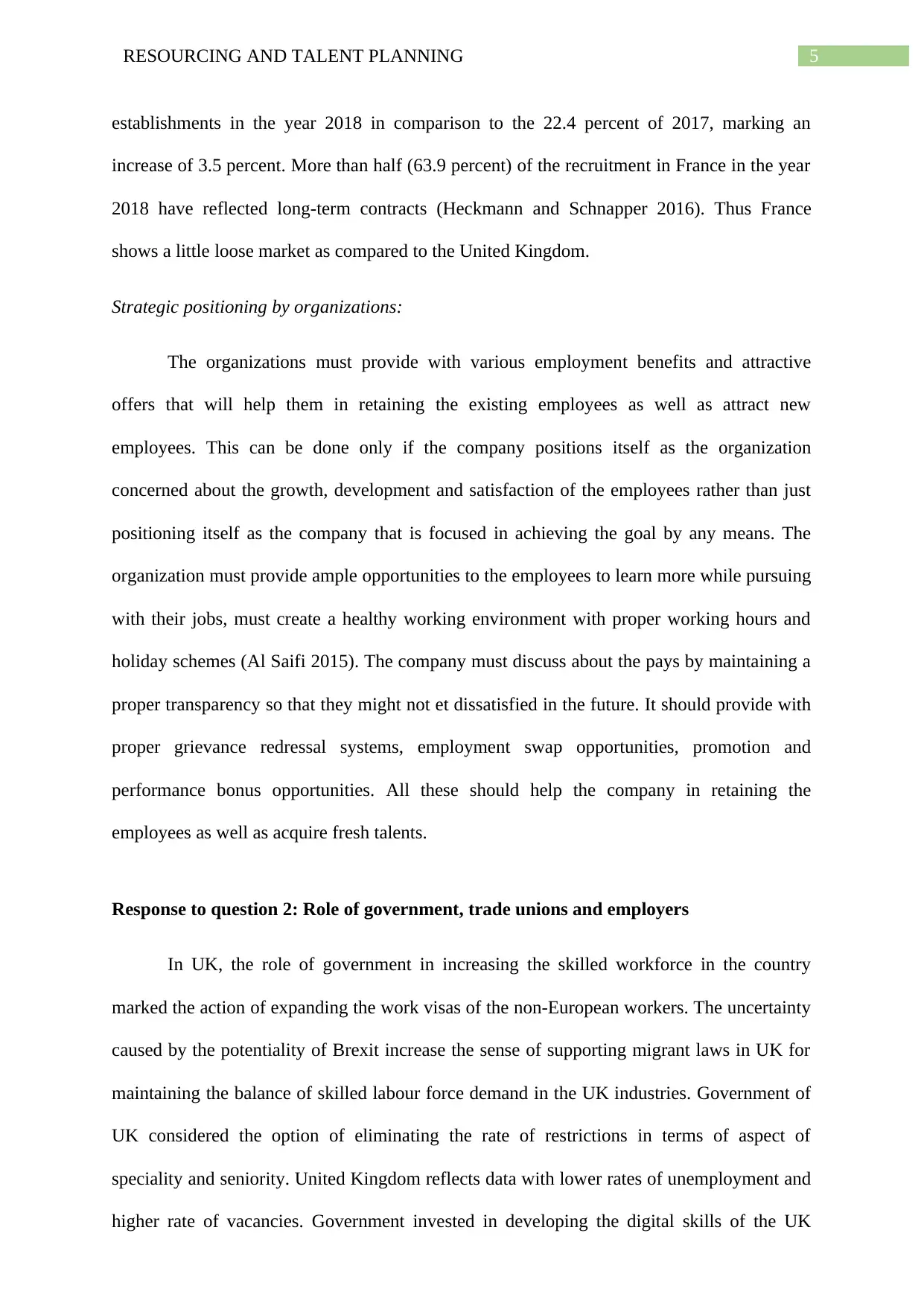
5RESOURCING AND TALENT PLANNING
establishments in the year 2018 in comparison to the 22.4 percent of 2017, marking an
increase of 3.5 percent. More than half (63.9 percent) of the recruitment in France in the year
2018 have reflected long-term contracts (Heckmann and Schnapper 2016). Thus France
shows a little loose market as compared to the United Kingdom.
Strategic positioning by organizations:
The organizations must provide with various employment benefits and attractive
offers that will help them in retaining the existing employees as well as attract new
employees. This can be done only if the company positions itself as the organization
concerned about the growth, development and satisfaction of the employees rather than just
positioning itself as the company that is focused in achieving the goal by any means. The
organization must provide ample opportunities to the employees to learn more while pursuing
with their jobs, must create a healthy working environment with proper working hours and
holiday schemes (Al Saifi 2015). The company must discuss about the pays by maintaining a
proper transparency so that they might not et dissatisfied in the future. It should provide with
proper grievance redressal systems, employment swap opportunities, promotion and
performance bonus opportunities. All these should help the company in retaining the
employees as well as acquire fresh talents.
Response to question 2: Role of government, trade unions and employers
In UK, the role of government in increasing the skilled workforce in the country
marked the action of expanding the work visas of the non-European workers. The uncertainty
caused by the potentiality of Brexit increase the sense of supporting migrant laws in UK for
maintaining the balance of skilled labour force demand in the UK industries. Government of
UK considered the option of eliminating the rate of restrictions in terms of aspect of
speciality and seniority. United Kingdom reflects data with lower rates of unemployment and
higher rate of vacancies. Government invested in developing the digital skills of the UK
establishments in the year 2018 in comparison to the 22.4 percent of 2017, marking an
increase of 3.5 percent. More than half (63.9 percent) of the recruitment in France in the year
2018 have reflected long-term contracts (Heckmann and Schnapper 2016). Thus France
shows a little loose market as compared to the United Kingdom.
Strategic positioning by organizations:
The organizations must provide with various employment benefits and attractive
offers that will help them in retaining the existing employees as well as attract new
employees. This can be done only if the company positions itself as the organization
concerned about the growth, development and satisfaction of the employees rather than just
positioning itself as the company that is focused in achieving the goal by any means. The
organization must provide ample opportunities to the employees to learn more while pursuing
with their jobs, must create a healthy working environment with proper working hours and
holiday schemes (Al Saifi 2015). The company must discuss about the pays by maintaining a
proper transparency so that they might not et dissatisfied in the future. It should provide with
proper grievance redressal systems, employment swap opportunities, promotion and
performance bonus opportunities. All these should help the company in retaining the
employees as well as acquire fresh talents.
Response to question 2: Role of government, trade unions and employers
In UK, the role of government in increasing the skilled workforce in the country
marked the action of expanding the work visas of the non-European workers. The uncertainty
caused by the potentiality of Brexit increase the sense of supporting migrant laws in UK for
maintaining the balance of skilled labour force demand in the UK industries. Government of
UK considered the option of eliminating the rate of restrictions in terms of aspect of
speciality and seniority. United Kingdom reflects data with lower rates of unemployment and
higher rate of vacancies. Government invested in developing the digital skills of the UK
⊘ This is a preview!⊘
Do you want full access?
Subscribe today to unlock all pages.

Trusted by 1+ million students worldwide

6RESOURCING AND TALENT PLANNING
organizations by introducing Tech partnerships, making it free for all the employers in United
Kingdom (Boland 2016). The government of United Kingdom understood the importance of
increasing digital skills of the workforce. The digitalization scheme will contribute majorly in
the covering the gap between labour force demand and supply. This concept by government
will majorly contribute towards the factor of up skilling the labour force of United Kingdom
in various sectors of UK. For the purpose of increasing skills and responding to the increasing
gap between demand and supply of skilled of labour force in France, government of France
decided to restructure the professional apprenticeship scheme. The initiative of French
government for the full time and part time labours contributes to the opportunity of providing
the provision of spending 5,000 Euros for developing their skills and competencies of their
preference (Beharrell and Philo 2016).
Unions reflect efforts towards improving the wage structure of labour force. The
practice of improving wage structure can attract the skilled labourers for recruitment in the
organizations. Improved working conditions by the efforts of labour unions helps in
improving the working conditions of the labour force, which in return helps in attracting
skilled labour force from around the world. The French trade union reflects strong and
effective negotiation power. Under the French law, the trade union represents all the existent
employees with an average of 50 plus staff members in both council and in the council of
health and safety.
These must be consulted regularly by bosses on a vast range of detailed managerial
decisions. This gives trade unions a daily say in the running of companies across the private
sector, which accounts for the real strength of their voice. The influence of trade union of UK
is not significantly high as compared to France as currently UK reflects around 26 percent of
the total population of labour force are union members. Only one of the trade unions holds a
significant amount of influence, TUC (Trade Union Congress).
organizations by introducing Tech partnerships, making it free for all the employers in United
Kingdom (Boland 2016). The government of United Kingdom understood the importance of
increasing digital skills of the workforce. The digitalization scheme will contribute majorly in
the covering the gap between labour force demand and supply. This concept by government
will majorly contribute towards the factor of up skilling the labour force of United Kingdom
in various sectors of UK. For the purpose of increasing skills and responding to the increasing
gap between demand and supply of skilled of labour force in France, government of France
decided to restructure the professional apprenticeship scheme. The initiative of French
government for the full time and part time labours contributes to the opportunity of providing
the provision of spending 5,000 Euros for developing their skills and competencies of their
preference (Beharrell and Philo 2016).
Unions reflect efforts towards improving the wage structure of labour force. The
practice of improving wage structure can attract the skilled labourers for recruitment in the
organizations. Improved working conditions by the efforts of labour unions helps in
improving the working conditions of the labour force, which in return helps in attracting
skilled labour force from around the world. The French trade union reflects strong and
effective negotiation power. Under the French law, the trade union represents all the existent
employees with an average of 50 plus staff members in both council and in the council of
health and safety.
These must be consulted regularly by bosses on a vast range of detailed managerial
decisions. This gives trade unions a daily say in the running of companies across the private
sector, which accounts for the real strength of their voice. The influence of trade union of UK
is not significantly high as compared to France as currently UK reflects around 26 percent of
the total population of labour force are union members. Only one of the trade unions holds a
significant amount of influence, TUC (Trade Union Congress).
Paraphrase This Document
Need a fresh take? Get an instant paraphrase of this document with our AI Paraphraser
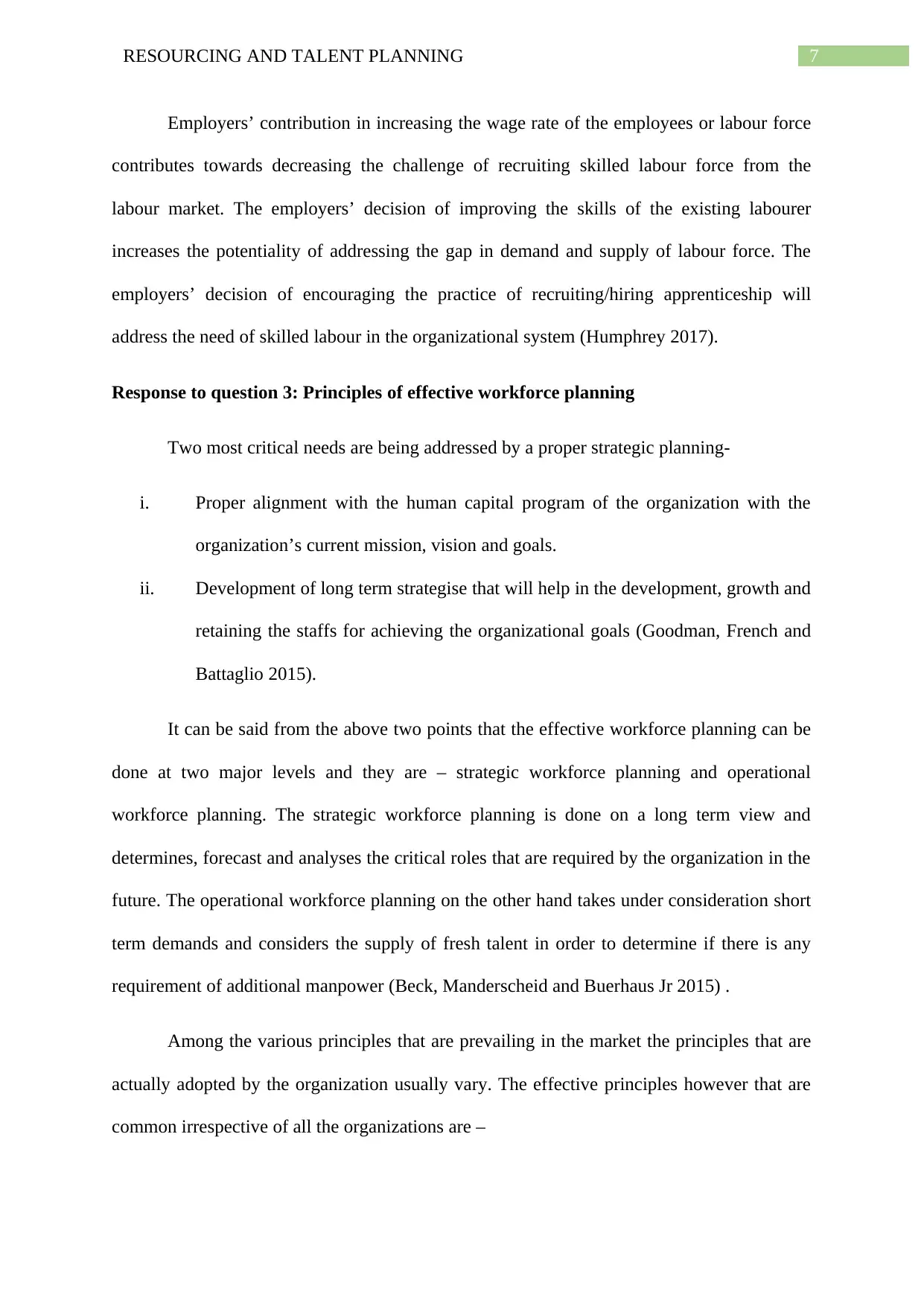
7RESOURCING AND TALENT PLANNING
Employers’ contribution in increasing the wage rate of the employees or labour force
contributes towards decreasing the challenge of recruiting skilled labour force from the
labour market. The employers’ decision of improving the skills of the existing labourer
increases the potentiality of addressing the gap in demand and supply of labour force. The
employers’ decision of encouraging the practice of recruiting/hiring apprenticeship will
address the need of skilled labour in the organizational system (Humphrey 2017).
Response to question 3: Principles of effective workforce planning
Two most critical needs are being addressed by a proper strategic planning-
i. Proper alignment with the human capital program of the organization with the
organization’s current mission, vision and goals.
ii. Development of long term strategise that will help in the development, growth and
retaining the staffs for achieving the organizational goals (Goodman, French and
Battaglio 2015).
It can be said from the above two points that the effective workforce planning can be
done at two major levels and they are – strategic workforce planning and operational
workforce planning. The strategic workforce planning is done on a long term view and
determines, forecast and analyses the critical roles that are required by the organization in the
future. The operational workforce planning on the other hand takes under consideration short
term demands and considers the supply of fresh talent in order to determine if there is any
requirement of additional manpower (Beck, Manderscheid and Buerhaus Jr 2015) .
Among the various principles that are prevailing in the market the principles that are
actually adopted by the organization usually vary. The effective principles however that are
common irrespective of all the organizations are –
Employers’ contribution in increasing the wage rate of the employees or labour force
contributes towards decreasing the challenge of recruiting skilled labour force from the
labour market. The employers’ decision of improving the skills of the existing labourer
increases the potentiality of addressing the gap in demand and supply of labour force. The
employers’ decision of encouraging the practice of recruiting/hiring apprenticeship will
address the need of skilled labour in the organizational system (Humphrey 2017).
Response to question 3: Principles of effective workforce planning
Two most critical needs are being addressed by a proper strategic planning-
i. Proper alignment with the human capital program of the organization with the
organization’s current mission, vision and goals.
ii. Development of long term strategise that will help in the development, growth and
retaining the staffs for achieving the organizational goals (Goodman, French and
Battaglio 2015).
It can be said from the above two points that the effective workforce planning can be
done at two major levels and they are – strategic workforce planning and operational
workforce planning. The strategic workforce planning is done on a long term view and
determines, forecast and analyses the critical roles that are required by the organization in the
future. The operational workforce planning on the other hand takes under consideration short
term demands and considers the supply of fresh talent in order to determine if there is any
requirement of additional manpower (Beck, Manderscheid and Buerhaus Jr 2015) .
Among the various principles that are prevailing in the market the principles that are
actually adopted by the organization usually vary. The effective principles however that are
common irrespective of all the organizations are –
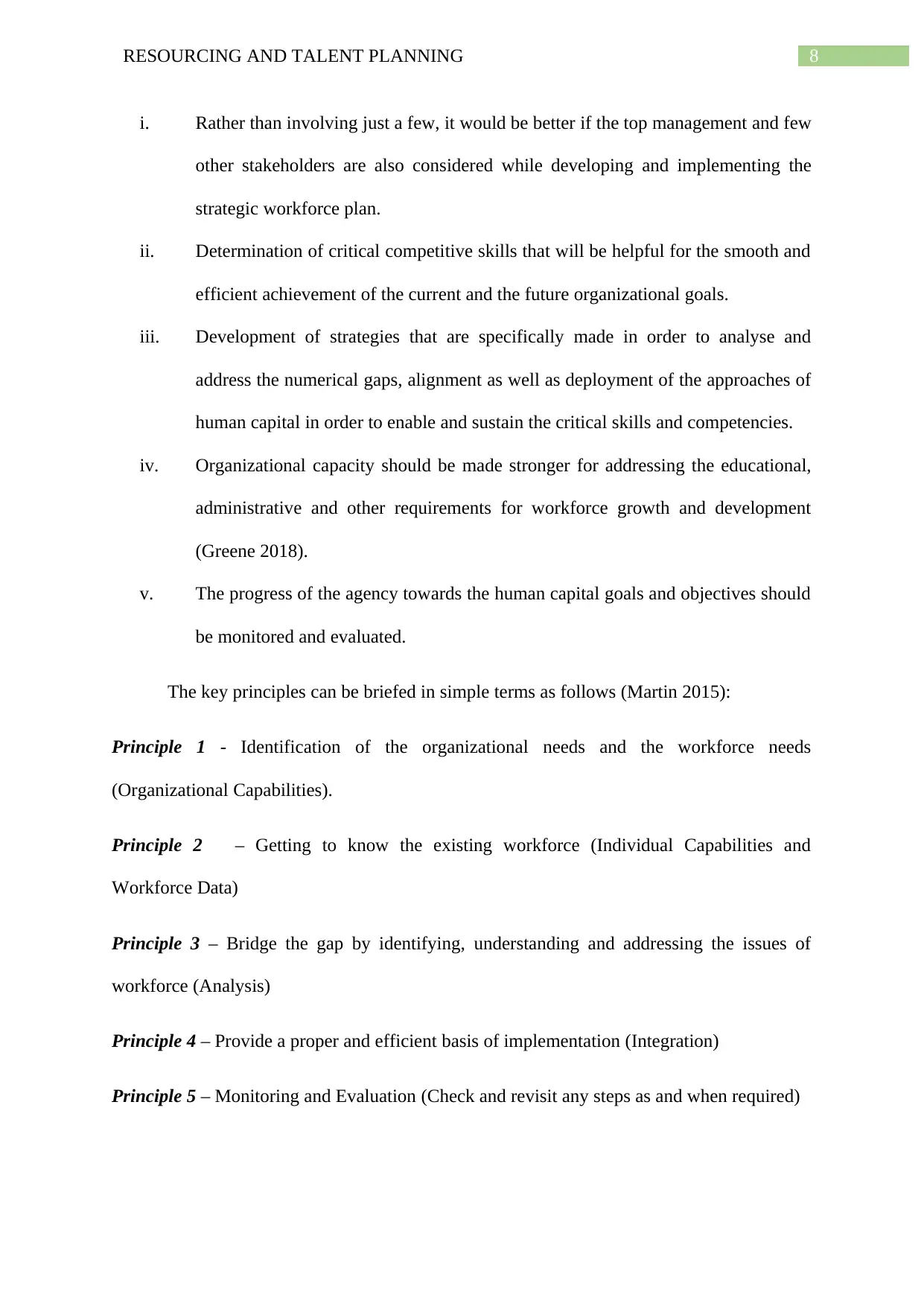
8RESOURCING AND TALENT PLANNING
i. Rather than involving just a few, it would be better if the top management and few
other stakeholders are also considered while developing and implementing the
strategic workforce plan.
ii. Determination of critical competitive skills that will be helpful for the smooth and
efficient achievement of the current and the future organizational goals.
iii. Development of strategies that are specifically made in order to analyse and
address the numerical gaps, alignment as well as deployment of the approaches of
human capital in order to enable and sustain the critical skills and competencies.
iv. Organizational capacity should be made stronger for addressing the educational,
administrative and other requirements for workforce growth and development
(Greene 2018).
v. The progress of the agency towards the human capital goals and objectives should
be monitored and evaluated.
The key principles can be briefed in simple terms as follows (Martin 2015):
Principle 1 - Identification of the organizational needs and the workforce needs
(Organizational Capabilities).
Principle 2 – Getting to know the existing workforce (Individual Capabilities and
Workforce Data)
Principle 3 – Bridge the gap by identifying, understanding and addressing the issues of
workforce (Analysis)
Principle 4 – Provide a proper and efficient basis of implementation (Integration)
Principle 5 – Monitoring and Evaluation (Check and revisit any steps as and when required)
i. Rather than involving just a few, it would be better if the top management and few
other stakeholders are also considered while developing and implementing the
strategic workforce plan.
ii. Determination of critical competitive skills that will be helpful for the smooth and
efficient achievement of the current and the future organizational goals.
iii. Development of strategies that are specifically made in order to analyse and
address the numerical gaps, alignment as well as deployment of the approaches of
human capital in order to enable and sustain the critical skills and competencies.
iv. Organizational capacity should be made stronger for addressing the educational,
administrative and other requirements for workforce growth and development
(Greene 2018).
v. The progress of the agency towards the human capital goals and objectives should
be monitored and evaluated.
The key principles can be briefed in simple terms as follows (Martin 2015):
Principle 1 - Identification of the organizational needs and the workforce needs
(Organizational Capabilities).
Principle 2 – Getting to know the existing workforce (Individual Capabilities and
Workforce Data)
Principle 3 – Bridge the gap by identifying, understanding and addressing the issues of
workforce (Analysis)
Principle 4 – Provide a proper and efficient basis of implementation (Integration)
Principle 5 – Monitoring and Evaluation (Check and revisit any steps as and when required)
⊘ This is a preview!⊘
Do you want full access?
Subscribe today to unlock all pages.

Trusted by 1+ million students worldwide

9RESOURCING AND TALENT PLANNING
Response to question 4
The career development plan
Development
Need/Goal
The development actions Measure/ Timing By whom
The aim is to enhance
the capability for
driving performance
through other people.
Te focus is to empower
the employees and offer
them coaching to
enable delivery of the
agreed standards.
The focus will be on being
able to describe the impact
of the under-performance for
both the organization and the
individual. The thinking
will be through the obstacles
to performance and identify
the ways to remove or
reduce these. The shifting
will be from providing
solutions to direct reports to
coaching. The employees
will obtain coaching from
the manager as well as the
hired coach. There will be
difficult conversations with
the peers, managers and
leaders. The participants
will participate in ‘Pathways
to Performance’ training
course (Brown et al. 2019).
The direct performance reviews
will be observed for ensuring the
performance expectations. There
will be 360 degree leadership
feedback. The commitment to
coaching-feedback will be
demonstrated from the staff-
ongoing The participants will
participate in the next available
program within the next 6 months
Self/Manager
The next goal will be
to work around the
individuals who are less
The participants will be
requested to take on the role
of ‘an idea facilitator’
The development plan will be
updated and the quality related
documents will be completed
Primarily by
self but the
manager will
Response to question 4
The career development plan
Development
Need/Goal
The development actions Measure/ Timing By whom
The aim is to enhance
the capability for
driving performance
through other people.
Te focus is to empower
the employees and offer
them coaching to
enable delivery of the
agreed standards.
The focus will be on being
able to describe the impact
of the under-performance for
both the organization and the
individual. The thinking
will be through the obstacles
to performance and identify
the ways to remove or
reduce these. The shifting
will be from providing
solutions to direct reports to
coaching. The employees
will obtain coaching from
the manager as well as the
hired coach. There will be
difficult conversations with
the peers, managers and
leaders. The participants
will participate in ‘Pathways
to Performance’ training
course (Brown et al. 2019).
The direct performance reviews
will be observed for ensuring the
performance expectations. There
will be 360 degree leadership
feedback. The commitment to
coaching-feedback will be
demonstrated from the staff-
ongoing The participants will
participate in the next available
program within the next 6 months
Self/Manager
The next goal will be
to work around the
individuals who are less
The participants will be
requested to take on the role
of ‘an idea facilitator’
The development plan will be
updated and the quality related
documents will be completed
Primarily by
self but the
manager will
Paraphrase This Document
Need a fresh take? Get an instant paraphrase of this document with our AI Paraphraser
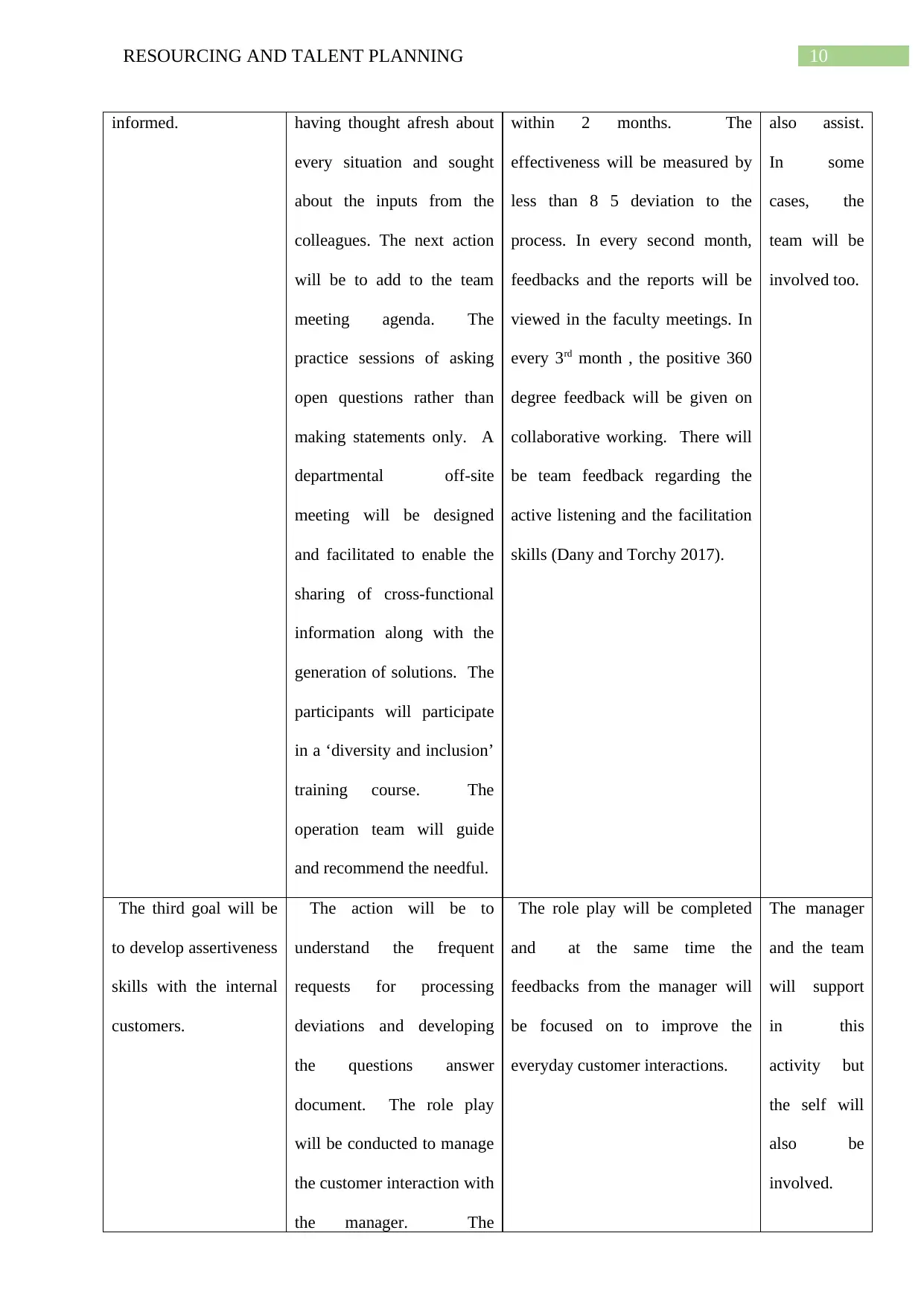
10RESOURCING AND TALENT PLANNING
informed. having thought afresh about
every situation and sought
about the inputs from the
colleagues. The next action
will be to add to the team
meeting agenda. The
practice sessions of asking
open questions rather than
making statements only. A
departmental off-site
meeting will be designed
and facilitated to enable the
sharing of cross-functional
information along with the
generation of solutions. The
participants will participate
in a ‘diversity and inclusion’
training course. The
operation team will guide
and recommend the needful.
within 2 months. The
effectiveness will be measured by
less than 8 5 deviation to the
process. In every second month,
feedbacks and the reports will be
viewed in the faculty meetings. In
every 3rd month , the positive 360
degree feedback will be given on
collaborative working. There will
be team feedback regarding the
active listening and the facilitation
skills (Dany and Torchy 2017).
also assist.
In some
cases, the
team will be
involved too.
The third goal will be
to develop assertiveness
skills with the internal
customers.
The action will be to
understand the frequent
requests for processing
deviations and developing
the questions answer
document. The role play
will be conducted to manage
the customer interaction with
the manager. The
The role play will be completed
and at the same time the
feedbacks from the manager will
be focused on to improve the
everyday customer interactions.
The manager
and the team
will support
in this
activity but
the self will
also be
involved.
informed. having thought afresh about
every situation and sought
about the inputs from the
colleagues. The next action
will be to add to the team
meeting agenda. The
practice sessions of asking
open questions rather than
making statements only. A
departmental off-site
meeting will be designed
and facilitated to enable the
sharing of cross-functional
information along with the
generation of solutions. The
participants will participate
in a ‘diversity and inclusion’
training course. The
operation team will guide
and recommend the needful.
within 2 months. The
effectiveness will be measured by
less than 8 5 deviation to the
process. In every second month,
feedbacks and the reports will be
viewed in the faculty meetings. In
every 3rd month , the positive 360
degree feedback will be given on
collaborative working. There will
be team feedback regarding the
active listening and the facilitation
skills (Dany and Torchy 2017).
also assist.
In some
cases, the
team will be
involved too.
The third goal will be
to develop assertiveness
skills with the internal
customers.
The action will be to
understand the frequent
requests for processing
deviations and developing
the questions answer
document. The role play
will be conducted to manage
the customer interaction with
the manager. The
The role play will be completed
and at the same time the
feedbacks from the manager will
be focused on to improve the
everyday customer interactions.
The manager
and the team
will support
in this
activity but
the self will
also be
involved.
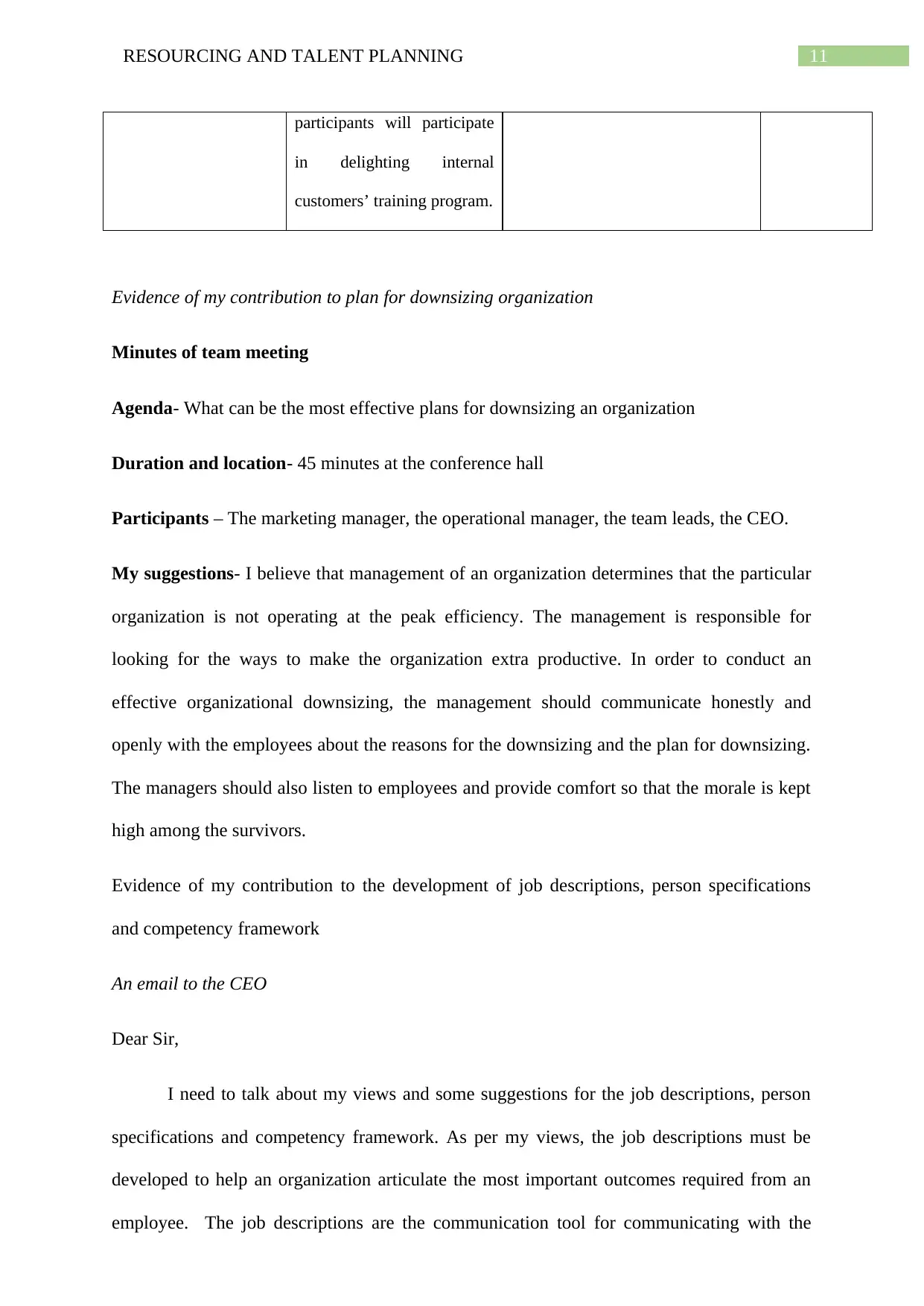
11RESOURCING AND TALENT PLANNING
participants will participate
in delighting internal
customers’ training program.
Evidence of my contribution to plan for downsizing organization
Minutes of team meeting
Agenda- What can be the most effective plans for downsizing an organization
Duration and location- 45 minutes at the conference hall
Participants – The marketing manager, the operational manager, the team leads, the CEO.
My suggestions- I believe that management of an organization determines that the particular
organization is not operating at the peak efficiency. The management is responsible for
looking for the ways to make the organization extra productive. In order to conduct an
effective organizational downsizing, the management should communicate honestly and
openly with the employees about the reasons for the downsizing and the plan for downsizing.
The managers should also listen to employees and provide comfort so that the morale is kept
high among the survivors.
Evidence of my contribution to the development of job descriptions, person specifications
and competency framework
An email to the CEO
Dear Sir,
I need to talk about my views and some suggestions for the job descriptions, person
specifications and competency framework. As per my views, the job descriptions must be
developed to help an organization articulate the most important outcomes required from an
employee. The job descriptions are the communication tool for communicating with the
participants will participate
in delighting internal
customers’ training program.
Evidence of my contribution to plan for downsizing organization
Minutes of team meeting
Agenda- What can be the most effective plans for downsizing an organization
Duration and location- 45 minutes at the conference hall
Participants – The marketing manager, the operational manager, the team leads, the CEO.
My suggestions- I believe that management of an organization determines that the particular
organization is not operating at the peak efficiency. The management is responsible for
looking for the ways to make the organization extra productive. In order to conduct an
effective organizational downsizing, the management should communicate honestly and
openly with the employees about the reasons for the downsizing and the plan for downsizing.
The managers should also listen to employees and provide comfort so that the morale is kept
high among the survivors.
Evidence of my contribution to the development of job descriptions, person specifications
and competency framework
An email to the CEO
Dear Sir,
I need to talk about my views and some suggestions for the job descriptions, person
specifications and competency framework. As per my views, the job descriptions must be
developed to help an organization articulate the most important outcomes required from an
employee. The job descriptions are the communication tool for communicating with the
⊘ This is a preview!⊘
Do you want full access?
Subscribe today to unlock all pages.

Trusted by 1+ million students worldwide
1 out of 19
Related Documents
Your All-in-One AI-Powered Toolkit for Academic Success.
+13062052269
info@desklib.com
Available 24*7 on WhatsApp / Email
![[object Object]](/_next/static/media/star-bottom.7253800d.svg)
Unlock your academic potential
Copyright © 2020–2025 A2Z Services. All Rights Reserved. Developed and managed by ZUCOL.





